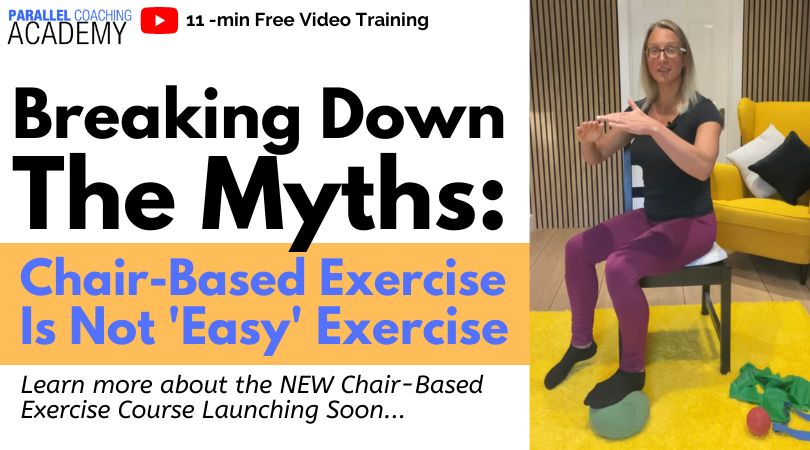Today’s blog breaks down the myths and misconceptions about chair-based exercise. You’ll learn that just because the exercise mode may be seated, doesn’t mean that it is EASY, or pointless.
You’ll also identify 4 benefits of chair-based exercise so you can instruct these exercises safely, confidently and effectively.
Start by watching the 11-minute video tutorial,
Watch: Chair-Based Exercise Is Not ‘Easy’ Exercise
Myths about Exercise:
Exercise is not just about getting sweaty, jumping around or lifting heavy resistance machines.
Exercise has the purpose of creating an adaptation in the body. Whether that is to get faster, fitter, healthier, leaner, stronger, or have less pain.
Let me introduce the SAID principle.
It is an acronym that stands for:
- Specific
- Adaptation to an
- Imposed
- Demand
This means that when we exercise, we IMPOSE a demand on our body. That demand is then met by an adaptation to our anatomy and physiology which results in finding that same activity easier next time.
Therefore, it’s not the exercise mode that is responsible for the result we want. It’s the fact that it CHALLENGED the anatomy and physiology enough, in a relevant way, to get a result.
That result then has to match the progression the client wants to see in their goal.
You could run or do a spin class if it challenged you both will challenge your Cardiovascular fitness.
You can list weights using a resistance machine or using a resistance band sitting in a chair, as long as it challenges you there will be an adaptation.
The Chair-Based Exercise Revolution
Chair-based exercise is often misunderstood as being “easy” or “less challenging” than traditional forms of fitness. However, this perception couldn’t be further from the truth.
In reality, chair-based exercise offers a unique and effective way to work out that is suitable for individuals of all ages and fitness levels.
Here’s why:
1. Whole Body Approach?
One common myth about chair-based exercise is that it only works the upper body.
In reality, a well-designed chair-based workout can engage multiple muscle groups, including the core, legs, and even the cardiovascular system.
It’s not just about sitting whilst you do bicep curls and tricep extensions. It’s about utilizing the chair as a versatile tool for a full-body workout.
Once you’ve learned the variables to tweak and the adaptations to make you’ll be able to challenge all of the components of fitness. This includes Cardiovascular, whole-body resistance training, Flexibility and motor skills.
2. Low-Impact, High-Benefit
One of the most significant advantages of chair-based exercise is its low-impact nature. This means less stress on joints, making it an excellent choice for individuals with arthritis, joint issues, or those recovering from injuries.
However, low impact doesn’t equate to low benefits. Chair-based exercises can help improve flexibility, motor skills, fitness and strength.
3. Intensity is Individual
Chair-based workouts can be adapted to suit individual fitness levels.
Just because you’re sitting doesn’t mean the workout can’t be challenging. By adjusting the range of motion, angles, speed, complexity, resistance, and repetitions, you can tailor the workout to your unique needs.
You might find one exercise easy, doesn’t mean that it is easy to your client. Adjusting the variables allows you to get the client to their desired RPE/ intensity.
Chair-based exercise can be as challenging as any other mode of exercise. You need to adapt the exercise to meet the needs of your client.
4. Inclusive
Perhaps the most significant advantage of chair-based exercise is its inclusivity. It provides a gateway to fitness for individuals with diverse abilities and needs.
Everyone can participate and benefit from chair-based workouts, regardless of age, fitness level, disability, or mobility limitations.
This inclusivity promotes a sense of community and empowerment among participants.
However, don’t be fooled into thinking that Chair-Based exercise is only for clients who “can’t go to the gym or use gym kit”. There are huge benefits for chair-based exercise in all abilities.
A client can use chair-based exercises as “home-work” sessions to help improve benefits in between PT sessions. It’s accessible if someone is new or underconfident for a gym environment. It can be gradually progressed for those with injuries, long-term conditions or in need of adaptations.
Embracing the Versatility of Chair-Based Exercise
In conclusion, it’s time to debunk the myth that chair-based exercise is an “easy” workout. Instead, it’s a smart, effective, and accessible choice for people of all backgrounds.
Whether you train older adults looking to stay active, those recovering from an injury, or want to expand your exercise library, chair-based exercise offers a world of benefits.
So, let’s reframe our perspective on fitness. It’s not solely about high-intensity workouts; it’s about finding the right exercise modality that suits your needs and goals.
Are you ready to challenge the chair-based exercise myth?
Become a Confident and knowledgeable Chair Based Exercise Instructor
NEW Chair-Based Exercise Course by Parallel Coaching
Unlock the skills to lead engaging chair-based exercise sessions and inspire others to stay active.
You will learn the significant physical, mental and social health benefits of chair-based exercise, and how to engage with your participants effectively.
You will be taught appropriate exercises to improve aerobic fitness, muscular strength, mobility and flexibility in frailer older adults and disabled adults, and how to adapt them to meet individual needs.
Find out more and join us here:
https://courses.parallelcoaching.co.uk/products/chair-based-exercise-course/
Dedicated to More
Hayley “Chair-Based Exercise Is Not ‘Easy’ Exercise” Bergman
Parallel Coaching
P.S. You can also find us on the following platforms:
Instagram: https://www.instagram.com/parallelcoaching
Facebook: https://www.facebook.com/ParallelCoaching
Twitter: https://twitter.com/ParallelCoach
YouTube: http://bit.ly/2F1Z1bs
Read more specialist blogs: HERE

